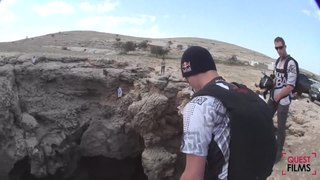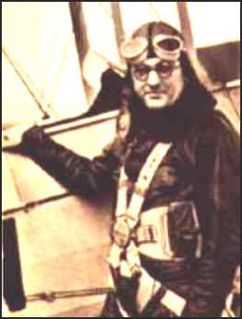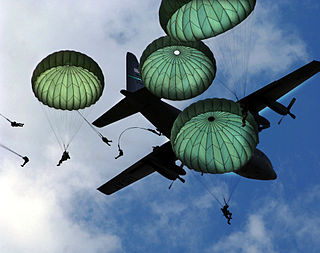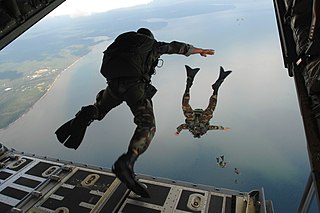
BASE jumping, also sometimes written as B.A.S.E. jumping, is parachuting or wingsuit flying from a fixed structure or cliff. "BASE" is an acronym that stands for four categories of fixed objects from which one can jump: building, antenna, span, and earth (cliff). Due to the lower altitudes of the jumps, BASE jumping is significantly more dangerous than skydiving from a plane. In the U.S., BASE jumping is currently regarded by many as a fringe extreme sport or stunt.

High-altitude military parachuting is a method of delivering military personnel, military equipment, and other military supplies from a transport aircraft at a high altitude via free-fall parachute insertion. Two techniques are used: HALO and HAHO.

Wingsuit flying is the sport of flying through the air using a wingsuit which adds surface area to the human body to enable a significant increase in lift. The modern wingsuit, first developed in the late 1990s, creates a surface area with fabric between the legs and under the arms. Wingsuits are sometimes referred to as "birdman suits", "squirrel suits", and "bat suits".

A drogue parachute is a parachute designed to be deployed from a rapidly moving object in order to slow the object, to provide control and stability, or as a pilot parachute to deploy a larger parachute. It was invented in Russia by Gleb Kotelnikov in 1912.

Bill Booth is an American engineer, inventor, and entrepreneur in the skydiving equipment manufacturing industry. His invention of the 3-ring release safety device has enhanced skydiving safety.

Automatic activation device (AAD) in skydiving terminology refers to an electronic-pyrotechnic or mechanical device that automatically opens the main or reserve parachute container at a preset altitude or after a preset time.

A slider is a small rectangular piece of fabric with a grommet near each corner used to control the deployment of a "ram-air" parachute. A ram-air parachute has a tendency to open very rapidly. At high velocities, the opening shock from such a rapid deployment can cause damage to the canopy or injury to the jumper. The slider was developed as a way of mitigating this. During deployment, the slider slides down from the canopy to just above the risers. It is slowed by air resistance as it descends and reduces the rate at which the lines can spread and therefore the speed at which the canopy can open and inflate. The slider also deflects some of the rising air column away from the center of the canopy as it inflates. This also helps moderate the speed of opening. This invention solved the rapid deployment problem with ram-air designs. Sliders also reduce the chance of the lines twisting to cause a malfunction.

A malfunction is a partial or total failure of a parachuting device to operate as intended. Malfunctions may require a skydiver to cut away his or her main parachute and deploy the reserve parachute.

A static line is a fixed cord attached to a large, stable object. It is used to open parachutes automatically for paratroopers and novice parachutists.

A pilot chute is a small auxiliary parachute used to deploy the main or reserve parachute. The pilot chute is connected to the deployment bag containing the parachute by a bridle. On modern skydiving rigs three types of pilot chutes can be found:

Tandem skydiving or tandem parachuting refers to a type of skydiving where a student skydiver is connected to a harness attached to a tandem instructor. The instructor guides the student through the whole jump from exit through freefall, piloting the canopy, and landing. The student needs only minimal instruction before making a tandem jump with the instructor. In the United States most skydiving centers and clubs require that you be 18 years or older to skydive whereas in other countries the minimum age can be lower or higher. This is one of three commonly used training methods for beginning skydivers; the others being static line and Accelerated Freefall.
The Skyhook is United Parachute Technologies version of a Main-Assisted Reserve Deployment system (MARD), a safety feature on skydiving parachute systems. It builds on the concept underlying an ordinary reserve static line (RSL), which uses the force of the departing main parachute to open the reserve parachute compartment after the malfunctioning main parachute is cut-away, by further using the force of the departing main parachute to extract the reserve parachute out of the reserve compartment. This greatly decreases the time, and hence loss of altitude, required to fully open the reserve parachute.
Cut-away is a skydiving term referring to disconnecting the main parachute from the harness-container in case of a malfunction in preparation for opening the reserve parachute. The 3-ring release system on parachutes allows a rapid cut-away in the event of an emergency.

Accelerated freefall (AFF) is a method of skydiving training. This method of skydiving training is called "accelerated" because the progression is the fastest way to experience solo freefall, normally from 10,000 to 15,000 feet "Above Ground Level" (AGL). In static line progression, more jumps are required to experience freefall, but the jumps are less expensive for the student as one instructor can dispatch multiple students per load and students are initially dispatched from lower altitudes. Under accelerated freefall, one or sometimes two instructors are dedicated just to one student.

Leslie Leroy Irvin made the first premeditated free-fall parachute jump in 1919.
Irvin was born in Los Angeles. He became a stunt-man for the fledgling Californian film industry, for which he had to perform acrobatics on trapezes from balloons and then make descents using a parachute. Irvin made his first jump when aged fourteen. For a film called Sky High, he first jumped from an aircraft from 1,000 feet in 1914. He developed his own static line parachute as a life-saving device in 1918 and jumped with it several times.

Georgia Ann Thompson Broadwick, or Georgia Broadwick, was an American pioneering parachutist. She was nicknamed 'Tiny', as she weighed only 85 pounds (39 kg) and was 5 feet (1.5 m) tall. She invented the ripcord.

The T-10 Parachute is a series of static line-deployed parachutes used by the United States armed forces for combat mass-assault airborne operations and training. The T-10 parachute was introduced in the early 1950s. In 1976, the B model introduced the anti-inversion net; in 1986, the C model was introduced, which changed the pocket band free length from 4" to 7½". The T-10D, adopted in 2000, includes the detachable pack tray, which in itself includes the 15' universal static line and 5' extension static line. The T-10D is currently being replaced by the T-11 parachute system. In 2006, all T-10C parachutes were revised by adding one static line stow bar to each side of the pack tray; the material for the T-10C was also changed to the Army's Foliage Green #504.
Charles Broadwick was an American pioneering parachutist and inventor. Speaking about Broadwick, an executive director of the U.S. Parachute Association, Ed Scott, said "just about all modern parachute systems" use ideas Broadwick developed: "an integrated, form-fitting harness and container system nestled on the back."
Broadwick also developed the static line for deploying a parachute where a line attached to an aircraft pulls the parachute from its pouch. Static lines are still used today, for instance by paratroopers and novice skydivers. U.S. Army Warrant Officer Jeremiah Jones commented, "[Broadwick] is like the grandfather of paratroopers."
In addition, Broadwick demonstrated parachute jumps at fairs and taught and equipped famous female parachutist Tiny Broadwick.
Luke Aikins is an American professional skydiver, BASE jumper, pilot, and aerial photographer. He is the first person to intentionally dive from mid-tropospheric altitude and land safely without a parachute or a wingsuit and the second skydiver to intentionally and safely land without using a parachute.
















